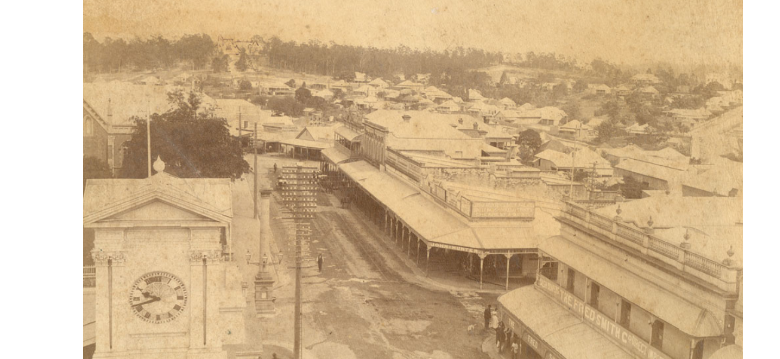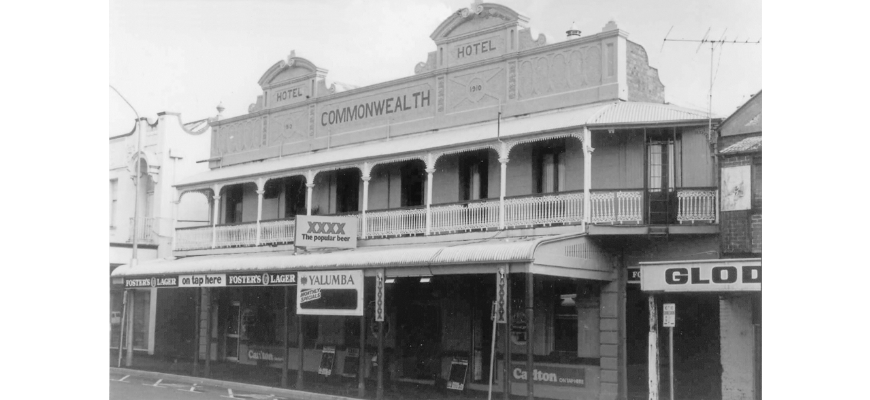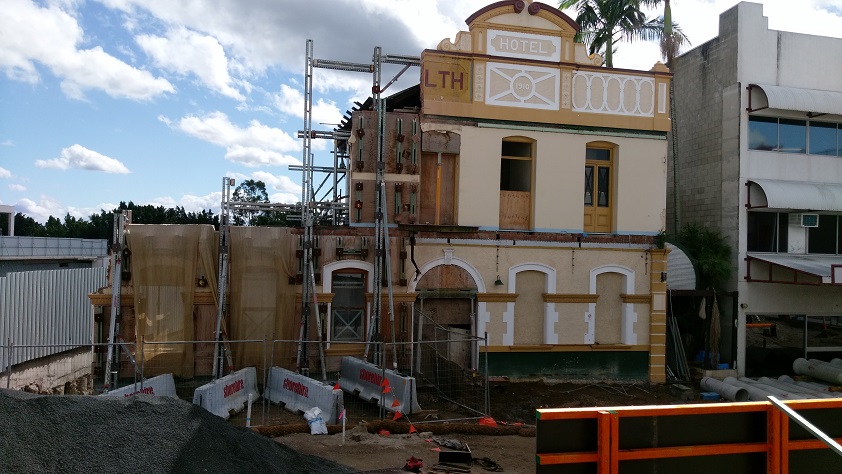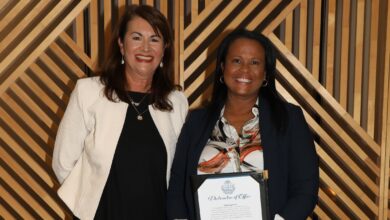A visit to the country
In 1910, the bustling town of Ipswich, located outside the capital city of Brisbane, boasted a wide selection of hotels, shops, cafes, cinemas and oyster saloons, making it the ideal holiday destination.
With plenty to see and do, including day trips to the surrounding countryside, evening dances and concerts, shopping and dining, the savvy traveler could find affordable accommodation at any one of a number of local hotels, often with their meals included. One of these was the newly-built Commonwealth Hotel, located on Union Street directly opposite the railway station, which opened its doors in October 1910 under the management of experienced hotelier, James Brisbane.
Described in a newspaper article as “a splendid hostelry” that was “remarkable for its architectural design”, the Commonwealth Hotel was a two-storey federation-style building with high ceilings, “four sitting rooms, a nicely ornamented bar, a large dining room and 13 large and well-ventilated bedrooms”, as well as a kitchen, scullery and pantry.
The new hotel also featured “new and most-up to-date furniture” throughout and according to the Queensland Times of 1912, “from the eastern side of the balcony a fine view of Limestone Hill and its surrounds may be obtained, and it is an aspect of this city that will be greatly appreciated by visitors to Ipswich”.
It was also a great place for longer-term boarders to live before the days of apartment living. Workers from a variety of industries could have a comfortable private room, meals and sometimes their washing done for them at a relatively low cost.
New hotel manager Harry Green took over in 1912, and by 1914 had transformed the old storage areas behind the building into an electric light plant and a mineral water manufacturing plant. The electric light was to be a great “boon” for the hotel’s visitors and boarders.
Travel from Brisbane was a breeze thanks to a quick 90 minute journey by steam train. Passengers would get off the train at Ipswich’s railway station which was just across the street from the Commonwealth Hotel.

Exploring early 1900s Ipswich
After breakfast in the dining room at the Commonwealth Hotel, guests could explore the nearby main streets of Ipswich without the need for a horse and sulky, though stabling was offered at most hotels during this time which was handy if you wanted to bring your own transport.
Ladies could slip over to the Palais Royal Hotel on the corner of Brisbane and East streets to have their hair attended to by Miss Keating. Miss Keating specialised in artistic ornamental hair work and offered the best range of vegetable hair dyes that could be procured.
And you could visit Miss Venables, a medical clairvoyant, herbalist, magnetic healer and masseuse who would diagnose your ailments with a lock of your hair.
Local flavour
Until 1912, most hotels provided a free counter lunch with the purchase of a threepenny or sixpenny ale.
What started as a simple marketing idea to increase beer sales resulted in backlash from the Temperance movement, who felt that this encouraged daytime drinking. It also raised the concerns of members of the United Licenced Victuallers Association (ULVA), who felt that counter lunches lacked hygiene if customers were allowed to serve their own food from a buffet.
There were even concerns that “Opium smokers would splutter over food, consumptives would contaminate it and even a leper might handle it,” according to the Queensland Times of the day.
However, even if the counter lunch was a thing of the past, there were plenty of other dining options in Ipswich in the early 1900s.
Hotel guests would likely have enjoyed breakfast in the Commonwealth’s modern, newly-appointed dining room.
Depending on the cost, breakfast would most likely have included freshly made bread, marmalade, butter, an egg, tea and maybe coffee. Hot breakfasts during this time were likely to consist of chops, stewed tripe, kidneys, stew or cutlets served with tea, coffee, bread and butter.
For dining and light refreshments beyond the Commonwealth’s dining room, guests could visit a number of cafes in the city including Jack Black’s establishment on Brisbane Street.
Mr Black ran what he described in the Queensland Times as the city’s “premier oyster saloon and dining rooms” in Brisbane Street, next door to the Palais Royal Hotel. For a reasonable price, one could enjoy fresh oysters, fish, prawns and boiled ham, with “fish luncheons and oyster suppers a specialty”.
Visitors could also enjoy a relaxing picnic on the banks of the Bremer River or take in the fresh air and greenery at Queens Park. Picnic provisions could be found at any one of a number of the city’s grocery stores, where hungry customers could find a diverse range of treats.
For just 7 pence, one could buy a can of herrings in tomato sauce, tinned cherries in syrup for 8 pence, a selection of cakes, sandwiches and fizzy drinks from Whitehouse Café in Nicholas Street, or pick up a tin of Veal and Tongue Pate from Barry and Roberts’ grocery store in Brisbane Street to make your own picnic sandwiches.

A potted history of the pub
A fashion-forward city
The TC Beirne & Co department store was located right next door to the Commonwealth Hotel, with the latest fashions, shoes, gifts and homewares just a few steps away.
In October 1910, newspaper advertisements told the fashionable ladies that “The Smartest of Smart Costumes are at Beirne’s”, where they could purchase linen coats and skirts trimmed with piping or braiding (a steal at just 18 shillings, 11 pence), or a “smart little blouse and skirt” combination in white with embroidery and lace embellishments.
Muslin blouses were the best value at just two shillings, 11 pence.
Cribb and Foote
Just up Bell Street were the grand Cribb and Foote London Stores, which offered dozens of speciality departments from fancy imported foods to sporting goods, clothes, homewares, haberdashery, toys and more.
Cribb and Foote also had a range of the latest gifts including sweets dishes, cream jugs and jam dishes from just a shilling each.
Small speciality stores like Miss Hoare’s Ladies and Children’s Clothing Store in Brisbane Street were also open where visitors could shop for the new season’s fashion as well as homemade sweets.
Witherington and Co, the expert tailors in Brisbane Street, could create a made-to-measure gentleman’s suite made from pure indigo serge for just 75 shillings or, if you required a new Indian Pith helmet, boater, felt or straw hat, the Big Bargain Corner could assist with the city’s biggest display of hats.
Just for fun
As night fell in Ipswich at the turn of the nineteenth century, street lamps were lit by Georgie Wall, who would stand on his pony’s back to reach the lamps.
It was in the early 1900s that the first open-air picture houses began to open, creating a whole new kind of nightlife for residents and visitors.
A trip to Martoo’s Olympian, owned and run by local character Bossie Martoo, was an occasion for dressing up and enjoying an evening of vaudeville, orchestral music, comedians, dancers, singers and, the main feature, a silent film direct from Hollywood due to the emergence of the American movie studio, and featuring stars such as Mary Pickford, Charlie Chaplin and Douglas Fairbanks.
Silent movies tended to be short in length and were shot in black and white, focusing on telling epic tales of train robbers, damsels in distress, cowboys, soldiers, pirates and princesses.
The city offered a choice of open-air picture houses including the Lyceum and the Athenian.
For music-lovers, the Ipswich Orchestral Society and the Blackstone-Ipswich Cambrian Choir held concerts, courting couples could attend any number of local dances, while for fans of the theatre, a number of popular shows visited Ipswich during this time, including Harry Clay’s Waxworks and Vaudeville Company.
The show, held at the town hall, included a famous opera singer, comedians, the Coleman Sisters who performed acrobatic feats, singers and dancers.
Sweet dreams
Once the amusements had wound down, visitors could return to the modern comfort and convenience of the stylish Commonwealth Hotel, where the ladies of the party could retire to the ladies’ room to partake of a cup of tea and a light supper in one of the four stylishly appointed sitting rooms, while the gentlemen repaired to the bar for a nightcap, before retiring for the evening to a large, airy bedroom.



Re “At some time. during the 1960s to 1980s the name was changed…” The name was changed as part of the refurbishment/reestablishment of the hotel connected with the opening of the Ipswich City Square in 1987/1988..
Hi, my father Kevin Basset owned from the mid 60s till he sold it in 1972, was still the Commonwealth hotel at the time of sale.